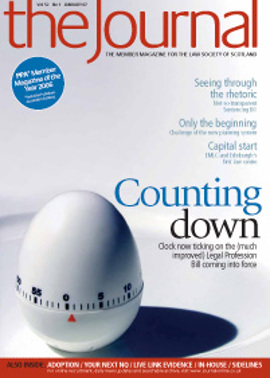Court rules catch up with live link TV

A new rule permitting the giving of evidence and the making of submissions by a live audio or television link has been enacted for civil proceedings in the Court of Session and the sheriff courts. The rule is in identical terms for both courts, and allows a party to apply for authority for the whole or part of the evidence of a witness or the party to be given, on cause shown, through a live link. The rule also applies to oral submissions by a party or his or her legal representative, including oral submissions in support of a motion.
The rule has been made on the recommendation of the Information Technology (“IT”) Committees of the Court of Session Rules Council and the Sheriff Court Rules Council. The terms of reference of the Court of Session committee are: “To make recommendations to the Rules Council on rules relative to the use of information technology in Court of Session procedure.” The sheriff court committee has a similarly broad remit. The committees now hold regular joint meetings under the chairmanship of Lord Macphail and Sheriff Iain Peebles QC.
Trust and discretion
The committees considered that in some cases it would be advantageous to allow the court to obtain evidence by live link where that would save time and expense, or would for any other reason be preferable to a commission to take evidence, without detriment to the interests of justice. In deciding on the form of the new rule, the committees concluded that it would be best to have a simple rule which left it to the court to decide in its discretion whether to allow the use of a live link and, if so, to impose such conditions as it thought fit.
In England and Wales there is a simple rule on the taking of evidence through a video link (“videoconferencing” or “VCF”) or by other means. That rule is accompanied by a fairly elaborate practice direction on the taking of evidence by VCF which contains guidance for judges and practical advice for practitioners. The committees decided, however, that at this stage at least, practice notes in similar terms would not be necessary in Scotland. The committees understand that in practice the experience south of the border has been that normally the taking of evidence by VCF is comparatively straightforward. They therefore think that in Scotland the regulation of any necessary details in any given case may safely be left to the good sense of the judge or sheriff, after hearing parties on the arrangements proposed by the party applying for the use of the live link.
What the rule says
The rule is in these terms:“(1) On cause shown, a party may apply by motion for authority for the whole or part of– (a) the evidence of a witness or the party to be given; or (b) a submission to be made, through a live link.
“(2) In paragraph (1)– ‘witness’ means a person who has been or may be cited to appear before the court as a witness; ‘submission’ means any oral submission which would otherwise be made to the court by the party or his representative in person including an oral submission in support of a motion; and ‘live link’ means a live television link or such other arrangement as may be specified in the motion by which the witness, party or representative, as the case may be, is able to be seen and heard in the proceedings or heard in the proceedings and is able to see and hear or hear the proceedings while at a place which is outside the court room.”
They have the technology
Practitioners wishing to use a live television link may take advantage of the videoconferencing facilities which have been installed in every High Court location and in many of the larger sheriff court buildings. A full list of locations is available on the SCS website (www.scotcourts.gov.uk/resources/courtroomtech/courtroomtech.asp).
The standard installations consist of four flat-panel monitors each with a camera mounted above the screen, together with a videoconferencing unit and a main control unit, all of which are situated in the courtroom. The judge or sheriff has complete control of the equipment at all times. By this means the court can take the evidence of a witness who is present at any suitably equipped remote location if the judge or sheriff hearing the case is satisfied on cause shown, in terms of the new rule, that the witness’s evidence should be given in that way.
These courthouses also have a witness room in which a further screen and camera are installed. That witness room may be used to enable a witness to give evidence to any remote court (either in Scotland or elsewhere) or indeed to a court sitting in the same courthouse. If the court to which the witness is to give evidence is in Scotland, the presiding judge or sheriff again must be satisfied as above.
Operational matters
The videoconferencing facilities are available free of charge for use by any court practitioner, subject to the approval of the court, and under such conditions as it may see fit to impose.
SCS staff will operate the in-court equipment, but the arrangements to be made at the “far end” of the link are a matter for parties, subject to the approval of the judge or sheriff. Guidance is available on the SCS website (see the above link). A test of the equipment should be arranged for the day before the case is due to be heard, to ensure that the equipment will function correctly and to allow parties an opportunity to familiarise themselves with the facilities.
Any practitioner requiring further information about the availability and use of courtroom videoconferencing equipment should contact the Electronic Service Delivery Unit (ESDU) at:
1 Mart Street, Saltmarket, Glasgow G1 5NA
(e: esdu@scotcourts.gov.uk; t: 0141 559 4590; fax: 0141 559 4585).
Wider issues
In addition to framing the live link rule, the committees have been examining other ways in which IT could be used in the civil courts. They are convinced that the carefully devised use of IT is now essential to the efficient and economical delivery by the civil courts of the services they offer to the public. By means of IT there is scope for significant reductions in delay and expense, the improvement of access to justice, and the formation of a modern and forward-looking system of civil procedure.
In particular, the committees consider that a system should be put in place for the electronic submission and transfer of documentation in civil court proceedings. Their view is that in principle all papers for court cases – pleadings, motions, minutes, interlocutors, documentary productions and the like – should be able to be transmitted to and from the court in electronic form, stored electronically, and be available to the judge or sheriff and to the parties’ legal advisers in electronic form. The experience of other jurisdictions comparable in size and character to Scotland, which are already using IT in this way, shows that such arrangements are perfectly feasible. The essentially paper-based regime which we have had for so long in the Scottish courts is coming to seem a quaint anachronism. Together with many other members of the legal profession, the committees hope that significant progress will soon be made towards the introduction of IT in the civil courts.
In this issue
- The Isle of Man
- Contractual handcuffs: enhanced redundancy rights
- Strength of purpose
- Cleared for take-off
- Countdown phase
- A quiet revolution
- Acting your age
- Adopting new solutions
- Clear as mud?
- Majoring in minorities
- Believe in the future
- Appreciation: Dr J Stuart Fair
- Grow your own assistant
- On the radar
- Status of the expert's report
- Rewarding experience
- Restructuring - in hindsight
- Court rules catch up with live link TV
- Scottish Solicitors' Discipline Tribunal
- Website reviews
- Book reviews
- Top notch training
- A clearer way to deal
- Not the best option
- Letting in the disabled
- Single survey: have your say






